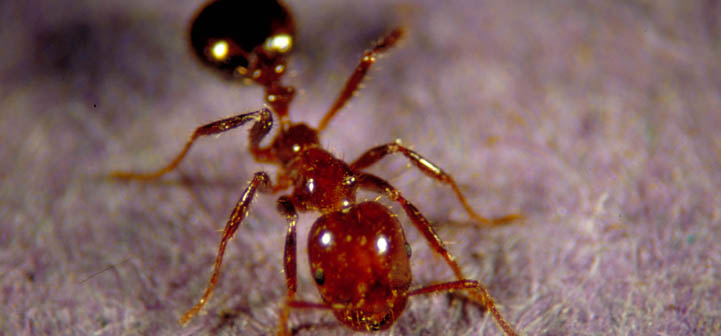 Classical or self-sustaining biological control is the use of imported natural enemies to suppress pests.
Classical or self-sustaining biological control is the use of imported natural enemies to suppress pests.
Self-sustaining biological control can be an effective and environmentally safe method to permanently control pests over wide areas. As such, it is the basis for many integrated pest management (IPM) programs.
In South America, the native habitat for imported fire ants (red and black), populations are much lower than populations in the southern United States and other areas where imported fire ants have been accidentally introduced (Porter et al. 1992, 1997; also see International page).
This situation is thought to arise because natural enemies (predators, parasites and pathogens) that keep populations low in South America were not imported along with this ant. Efforts have been made to introduce natural enemies to the invasive ant populations in order to provide sustainable suppression.
Categories of Natural Enemies
Parasites
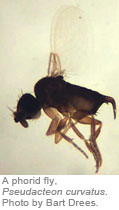 The term phorid fly is used for any of the flies belonging to the family Phoridae. There are about 230 genera in the family Phoridae. At least 3,000 species have been described, although there are many more undescribed species. Certain species of flies belonging to the genus Pseudacteon are known to attack fire ants (Solenopsis spp.). Pseudacteon species that attack fire ants in South America have been introduced into areas where Solenopsis invicta and Solenopsis richteri are invasive pests. Watch video of Pseudacteon phorid fly attacking a major imported fire ant worker (video by A. A. Calixto).
The term phorid fly is used for any of the flies belonging to the family Phoridae. There are about 230 genera in the family Phoridae. At least 3,000 species have been described, although there are many more undescribed species. Certain species of flies belonging to the genus Pseudacteon are known to attack fire ants (Solenopsis spp.). Pseudacteon species that attack fire ants in South America have been introduced into areas where Solenopsis invicta and Solenopsis richteri are invasive pests. Watch video of Pseudacteon phorid fly attacking a major imported fire ant worker (video by A. A. Calixto).
What laboratories lead research on parasitic phorid flies?
There are two laboratories leading research on parasitic phorid flies: The Imported Fire Ant and Household Insects research unit in Gainesville, Florida and the University of Texas at Austin Fire Ant Project.
Can I get phorid flies to release on my property to control fire ants?
No. It takes many Pseudacteon phorid flies or parasitized ants to establish a population released over a period of time (weeks). The flies are expensive to rear and require knowledge to establish successfully. Thus, they are not commercially available and releases are made by state or federal agency personnel. Once established, however, the flies spread and eventually all areas will have 3-6 species established on their properties (Callcott et al. 2011). Where established, flies can be observed hovering over disturbed ant nests or mounds and dive-bombing worker ants in their attempt to inject eggs into the ants’ bodies or thoracic segments.
How many species of phorid flies have been released?
In the native habitats of South America, around 20 species of Pseudacteon phorid flies attack the red imported fire ant. Of those, six have been released and established in the U.S.: Pseudacteon tricuspis, P. curvatus, P. obtusus, P. litoralis, P. nocens, and P. cultellatus (Callcott et al. 2011, Plowes et al. 2011, Porter et al. 2011, Porter et al. 2013). These species can be identified by the shape of their egg-laying structures called ovipositors (Porter and Pesquero 2001).
Other species of Pseudacteon phorid flies are being studied (Porter 1998). Because species differ in their: 1) behavior (some species occur mainly on disturbed ant mounds and others are attracted to foraging trails), 2) host size preference (some prefer smaller workers and vice versa), 3) time of attack during the day (some attack more during midday and some attack early morning and late evening), and 4) seasonality (in South America species vary in peak populations through the year), multiple species will need to be released and established before suppression, as seen in South America, may be achieved.
Will Pseudacteon phorid flies eradicate red imported fire ants?
No. In South America, where all 20 or so species of Pseudacteon phorid flies that attack and parasitize red imported fire ants, only 3% or less of the worker ants in a colony are parasitized – and good sized colonies contain roughly 200,000 ants! The fly’s ability to suppress foraging workers’ surface activity during daylight hours will hopefully allow competing native ant species to get out to forage for food and, establish and grow their colonies, so they can better compete with the fire ant. In short, these natural enemies have the potential to restore the balance of nature back towards our native and competitor ant species. That said, this effort would be unsuccessful if native ants are eliminated. Sustainable suppression potentially provided by these flies will benefit wildlife and agricultural areas where use of insecticide treatments will not be desirable, justified or sustainable.
Will Pseudacteon phorid flies attack other organisms?
Only other ants in the fire ant genus Solenopsis are attractive to the Pseudacteon phorid fly species being released. Most Pseudacteon species are very host specific – even between red and black or hybrid imported fire ants (Porter and Gilbert 2004). No other organisms are known to be hosts. Because the flies require the ant’s head capsule as their pupal case, they are unable to reproduce without the ants.
Where do Pseudacteon phorid flies occur today?
Species established are spreading up to 30 miles each year, so keeping up with where they are is difficult. The maps below show the known distribution of the flies.
Pseudacteon tricuspis
Pseudacteon curvatus
Pseudacteon obtusus
Pseudacteon litoralis
Pseudacteon nocens
Pseudacteon cultellatus
Related Links About Phorid Flies
- Video: Invasive Fire Ants Lose Heads to Flies – Discovery
- Fire Ant Treatment: Natural and Biological Control
- Fire Ant Project Fact Sheet – Potential Biological Control Agents for the Red Imported Fire Ant
- FAQ #1115: “Where can I buy decapitating flies and other natural enemies of fire ants to release in my yard?”
- FAQ #1084: “Will decapitating flies sting or bite? Are decapitating flies harmful?”
Pathogens
Kneallhazia (=Thelohania) solenopsae
 The microsporidian pathogen Kneallhazia (=Thelohania) solenopsae infects the red imported fire ant, Solenopsis.invicta, and the black imported fire ant, Solenopsis richteri (Sokolova and Fuxa 2008). In Argentina, about 13 percent of fire ant colonies have been found to be infected (Briano et al.2006). Surveys in the U.S. did not detect this disease organism until 1996, when it was discovered in Florida. Since then, K. solenopsae has also been found and/or released in most fire ant infested southeastern United States and California (Knutson & Drees 1998, Milks et al. 2008, Oi unpublished data 2014).
The microsporidian pathogen Kneallhazia (=Thelohania) solenopsae infects the red imported fire ant, Solenopsis.invicta, and the black imported fire ant, Solenopsis richteri (Sokolova and Fuxa 2008). In Argentina, about 13 percent of fire ant colonies have been found to be infected (Briano et al.2006). Surveys in the U.S. did not detect this disease organism until 1996, when it was discovered in Florida. Since then, K. solenopsae has also been found and/or released in most fire ant infested southeastern United States and California (Knutson & Drees 1998, Milks et al. 2008, Oi unpublished data 2014).
This microscopic pathogen infects immature and adult fire ants. Diseased ants, including queens, have shorter life spans. Infected queens become weaker and stop laying eggs. Over a period of several months to a year, the diseased colony declines (Williams et al. 1999). Infections of S. invicta have resulted in smaller colony sizes and population reductions of 63% in the U.S.
Kneallhazia solenopsae-infected fire ant colonies are more susceptible to fire ant bait than uninfected colonies (Drees and Gold 2003, Oi and Drees 2009). There is also evidence that infected fire ant populations will not re-infest areas that have been cleared of fire ants by insecticides as quickly as uninfected populations (Oi et al. 2008).
The pathogen can be detected using a phase contrast microscope to see octospores, the most common of the four types of spores produced by this organism. Genetic methods can also be used to detect the presence of the disease (Valles et al. 2002). Using these methods, Kneallhazia has been documented to occur widely in Texas and throughout the southern United States. The pathogen is apparently transmitted primarily by diseased ants moving between multiple-queen (polygynous) colonies (Oi and Valles 2009). In the U.S. this pathogen primarily attacks the red imported fire ant, but some genetic variants of K. solenopsae recently have been detected in the tropical fire ant Solenopsis geminata (Ascunce et al. 2010)
Distribution of Kneallhazia solenopsae
Viruses
 There are currently four viruses known to infect the red imported fire ant, three are positive-sense, single-stranded RNA viruses (Valles et al. 2004, Valles et al. 2007a, Valles and Hashimoto 2009) and one is a single-stranded DNA virus (Valles et al. 2013b). The DNA virus, Solenopsis invicta densovirus (SiDNV) has only been found in South American populations of Solenopsis invicta. It is currently being evaluated for use as a classical biological control agent against fire ants in the U.S. range. The RNA viruses include Solenopsis invicta virus 1 (SINV-1), SINV-2, and SINV-3. SINV-1 appears to cause a chronic infection in fire ant colonies that only causes symptoms when the ants are stressed (Valles 2012). It is found throughout theS. invicta U.S. population range (Valles et al 2007b. SINV-2 appears to target the testes of male fire ants and is associated with poor health in infected individuals. SINV-3 causes significant mortality among infected colonies in the laboratory and is therefore, considered the best candidate virus for use as both a classical biological control agent and/or biologically-based insecticide (biopesticide) for fire ants (Oi and Valles 2009).
There are currently four viruses known to infect the red imported fire ant, three are positive-sense, single-stranded RNA viruses (Valles et al. 2004, Valles et al. 2007a, Valles and Hashimoto 2009) and one is a single-stranded DNA virus (Valles et al. 2013b). The DNA virus, Solenopsis invicta densovirus (SiDNV) has only been found in South American populations of Solenopsis invicta. It is currently being evaluated for use as a classical biological control agent against fire ants in the U.S. range. The RNA viruses include Solenopsis invicta virus 1 (SINV-1), SINV-2, and SINV-3. SINV-1 appears to cause a chronic infection in fire ant colonies that only causes symptoms when the ants are stressed (Valles 2012). It is found throughout theS. invicta U.S. population range (Valles et al 2007b. SINV-2 appears to target the testes of male fire ants and is associated with poor health in infected individuals. SINV-3 causes significant mortality among infected colonies in the laboratory and is therefore, considered the best candidate virus for use as both a classical biological control agent and/or biologically-based insecticide (biopesticide) for fire ants (Oi and Valles 2009).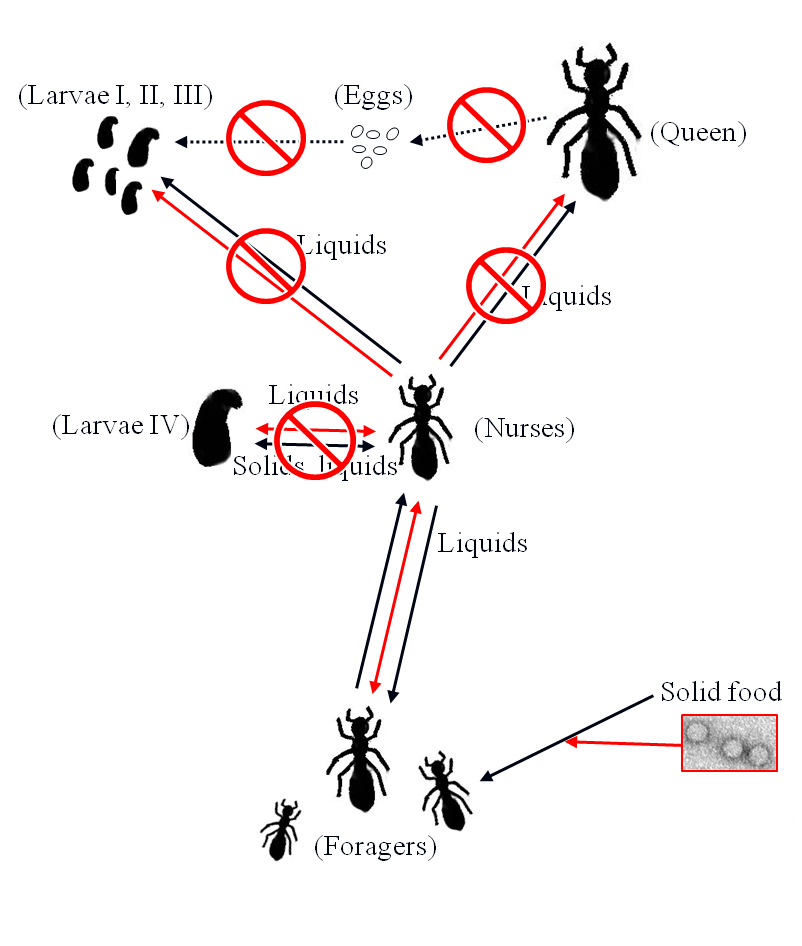
SINV-3 exhibits favorable characteristics for use as a natural agent to control fire ants. The virus is host-specific for pestiferous fire ants (Porter et al. 2013, Porter et al. 2015), is transmitted easily in the laboratory and field (Valles et al. 2013a, Valles and Oi 2014), and can be formulated in a bait (Valles et al 2013a). Recent work has shown that the virus interferes with normal foraging behavior (Valles et al. 2014). Worker ants cease to retrieve food for the colony resulting in larval mortality. Queens also become malnourished from lack of food.
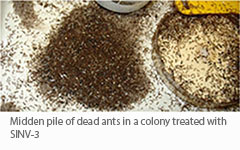 SINV-3-infected queens exhibit atrophied ovaries and produce significantly fewer eggs. SINV-3 has been successfully transmitted to field colonies in Florida (Valles and Oi 2014). Current studies are in progress to spread the infection into fire ant populations in California.
SINV-3-infected queens exhibit atrophied ovaries and produce significantly fewer eggs. SINV-3 has been successfully transmitted to field colonies in Florida (Valles and Oi 2014). Current studies are in progress to spread the infection into fire ant populations in California.
Distribution of SINV-1
Competitors
Ant Wars! Native and Exotic Competitor Ant Species
No open niches. In the world of ants, no ecological niche goes unexploited. As a group, the ants (Hymenoptera: Formicidae) are found in almost every habitat. If resources in a habitat become available, one or more ant species soon will exploit them and will colonize the habitat. Imported fire ants (Solenopsis invicta, S. richteri and their sexually reproductive hybrid) are very efficient colonizers of disturbed or open habitats within their introduce range (See geographic distribution of imported fire ants in the U.S.). This is accomplished through frequent mating flights throughout the year whenever proper conditions occur, colony ground migration and direct and/or indirect competition with other native and exotic ant species.
Direct competition. The very large imported fire ant colonies contain hundreds of thousands of worker ants that can dominate newly invaded areas by out-competing other ant species nesting and foraging on the surface in the same area. However, interactions between imported fire ants and other ant species can vary dramatically depending on the conditions and the resources available in space and time for a particular area. Only a few other ant species can win battles in direct competition. Imported fire ants have displaced, decimated or eliminated native Solenopsis fire ant species throughout much of the southern U.S. See video of S. invicta fighting S. geminata, a native fire ant species. In this video, S. geminata has the lighter brown body coloration and the major worker has a squarish head. Fire ants fight using their jaws or mandibles to bite and the stinger to inject venom into the body of other competitors to immobilize them.
Imported fire ants defend themselves when threatened by other ant species by raising their abdomens high in the air, extending their stingers and waving it, or “gaster flagging”, and then spraying venom. See video of a red imported fire ant, S. invicta, gaster flagging in the presence of the “Rasberry” crazy ant, Nylanderia species near pubens (now described as Nylanderia fulva by LaPolla et. al 2012, with tawny crazy ant as the approved common name of this species by the Entomological Society of America). The tawny crazy ant is an exotic invasive pest ants found in the Southern U.S. In Texas, where over 20 counties are known to have spot infestations as of 2011, the crazy ants have eliminated or displaced red imported fire ants. The crazy ant becomes so abundant that they rapidly discover and dominate resources used by fire ants, they also outnumber and irritate fire ants causing fire ant colonies to re-locate to the edges of crazy ant infestations. The crazy ants have no stinger, but instead posess an “acidopore” at the end of their abdomens which can excrete chemicals for defense or attack. However, in a one-to-one fight, a fire ant can kill a crazy ant as shown in this ant fight video.
Non-competitor ant species. Some ant species, like carpenter ants, do not seem to compete or interfere with imported fire ants. They nest in wooded in areas which are not prime fire ant habitat, and feed mainly on sugary foods. Workers are also generally larger than fire ants.
Other ant species compete with imported fire ants in different ways:

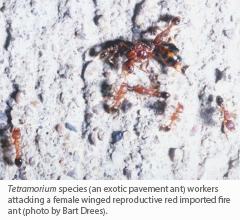 Attacking newly-mated, colony-founding queens: Many ant species, including imported fire ants have mating flights periodically throughout the year. Winged male and female ants leave the colony and mate mid-air. While the males usually die soon thereafter, mated females or queen ants return to the ground, remove their wings, then find or dig a burrow in which they begin laying eggs to start a new colony. Young queens are vulnerable the minute they touch the ground to predation by worker ants foraging for food. In areas dominated by native or exotic competitor ants, these species provide biotic resistance and help prevent new imported fire ant nests from developing (see figures below). Of course, when imported fire ants dominate the surface (usually when there are 20 fire ant mounds per acre or more), they prey on arriving colony-founding queens form other ant species, preventing them from establishing new colonies. Such is the case with the red harvester ant, Pogonomyrmex barbatus, and similar species. Watch a video of red harvester ant winged reproductives leaving their colony on a mating flight followed by red imported fire ants preying on a landing harvester ant queen.
Attacking newly-mated, colony-founding queens: Many ant species, including imported fire ants have mating flights periodically throughout the year. Winged male and female ants leave the colony and mate mid-air. While the males usually die soon thereafter, mated females or queen ants return to the ground, remove their wings, then find or dig a burrow in which they begin laying eggs to start a new colony. Young queens are vulnerable the minute they touch the ground to predation by worker ants foraging for food. In areas dominated by native or exotic competitor ants, these species provide biotic resistance and help prevent new imported fire ant nests from developing (see figures below). Of course, when imported fire ants dominate the surface (usually when there are 20 fire ant mounds per acre or more), they prey on arriving colony-founding queens form other ant species, preventing them from establishing new colonies. Such is the case with the red harvester ant, Pogonomyrmex barbatus, and similar species. Watch a video of red harvester ant winged reproductives leaving their colony on a mating flight followed by red imported fire ants preying on a landing harvester ant queen.

Raiding small incipient colonies. Laboratory studies have been conducted to document to tactics used by native and exotic competitor ant species to raid and eliminate small imported fire ant colonies (Rao and Vinson 2004, 2009).

Competition for resources. A number of native and exotic ant species are omnivorous like imported fire ants, and readilly recruit foraging workers to the same food resources. Dominant or more abundant ant species can overcome other ant species for food, thereby preventing less dominant species from obtaining the energy needed for survival.
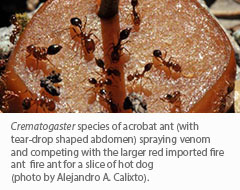
Crematogaster species of acrobat ant (with tear-drop shaped abdomen) spraying venom and competing with the larger Solenopsis invicta fire ant for a slice of hot dog (photo by Alejandro A. Calixto).
-
Surface dominance. Foraging worker ants leaving ant colonies maintain territories around colonies by fighting or outcompeting other ant species. Imported fire ants forage during moderate temperatures (65 to 95 degrees F). Some other ant species forage at higher temperatures than fire ants prefer, and may dominate during hot dry periods. Pogonomyrmex species are adapted to dry and hot enviroments where they can dominate under those conditions.
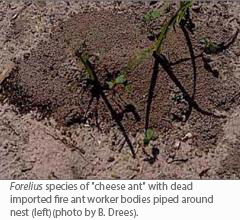 Forelius species (called “cheese ants” because of their blue cheese-like smell when crushed) is also another species that dominates during the hottest times of the day (watch Video). This species raids incipient fire ant colonies and deposit bodies of dead fire ants around their nests. Other species exhibiting a similar behavior are Dorymrmex spp. (called “pyramid ants” because of the shape of the colony) (Calixto et al. 2007a). Watch a video of a Dorymyrmex worker carrying a dead body of a fire ant after raiding an incipient colony (video by A. Calixto).
Forelius species (called “cheese ants” because of their blue cheese-like smell when crushed) is also another species that dominates during the hottest times of the day (watch Video). This species raids incipient fire ant colonies and deposit bodies of dead fire ants around their nests. Other species exhibiting a similar behavior are Dorymrmex spp. (called “pyramid ants” because of the shape of the colony) (Calixto et al. 2007a). Watch a video of a Dorymyrmex worker carrying a dead body of a fire ant after raiding an incipient colony (video by A. Calixto).
Native and exotic ant species and biological control. The release and establishment of natural enemies (predators, parasites and pathogens) of imported fire ants such as phorid flies and diseases may help reduce fitness of small and large, dominant imported fire ant colonies. However, the theory behind this classical biological control effort is that by reducing fire ant colony fitness, competitor ant species may be better able to compete with these exotic invasive species by allowing them to exploit food resources, establish and build their colonies and maintain their territories. Biological control of imported fire ants does not promise an ant free environment or the realease of niches for other species. Rather, the hope is that the “nicer” native and exotic competitor ants will flourish, better occupy the environment and help provide biotic resistance preventing high population levels of fire ants. Therefore, recognizing, preserving and encouraging these non-fire ant species is essential to the success of fire ant biological control. Preliminary studies have shown that the removal or reduction of fire ant numbers (colonies and workers) allows the resurgence of different native ant species (Calixto et al. 2007b).
Predators
Armadillos, antlions, spiders, birds, and horned lizards have been known to eat fire ants when given the opportunity, but are not known to have a major impact on imported fire ant populations.


Related
Literature Cited
Fire Ants in South America
Porter, S. D., H. G. Fowler, and W. P. Mackay. 1992. Fire ant mound densities in the United States and Brazil (Hymenoptera: Formicidae). J. Econ. Entomol. 85: 1154–1161.
Porter, S. D., D. F. Williams, R. S. Patterson, and H. G. Fowler. 1997. Intercontinental differences in the abundance of Solenopsis fire ants (Hymenoptera: Formicidae): an escape from natural enemies? Environ. Entomol. 26: 373–384.
Phorid flies:
Callcott, Anne-Marie, Sanford D. Porter, Ron D. Weeks, L. C. “Fudd” Graham, Seth J. Johnson, L. E. Gilbert. 2011. Fire ant decapitating fly cooperative release program (1994-2008): Two Pseudacteon species (P. tricuspis, P. curvatus) rapidly expand across imported fire ant populations in the southeastern United States. J. Insect Sci. 2011. 11.19. PDF
Plowes, R. M., P. J. Folgarait & L. E. Gilbert. 2011. The introduction of the fire ant parasitoid Pseudacteon nocens in North America: challenges when establishing small populations. BioControl DOI 10.1007/s10526-011-9428-9.
Porter, S. D. 1998. Biology and behavior of Pseudacteon decapitating flies (Diptera: Phoridae) that parasitize Solenopsis fire ants (Hymenoptera: Formicidae). Florida Entomol. 81: 292–309. PDF
Porter, S. D., and M. A. Pesquero. 2001. Illustrated key to Pseudacteon decapitating flies (Diptera: Phoridae) that attack Solenopsis saevissima complex fire ants in South America. Florida Entomol. 84: 691–699. PDF
Porter, S. D., and L. E. Gilbert. 2004. Assessing host specificity and field release potential of fire ant decapitating flies (Phoridae: Pseudacteon), pp. 152–176. In R. G. Van Driesche, T. Murray and R. Reardon [eds.], Assessing host ranges for parasitoids and predators used for classical biological control: a guide to best practice. FHTET-2004-03, USDA Forest Service, Morgantown, West Virginia. PDF
Porter, S. D., L. C. Graham, S. J. Johnson, L. G. Thead, and J. A. Briano. 2011. The large decapitating fly Pseudacteon litoralis (Diptera: Phoridae): Successfully established on fire ant populations in Alabama. Florida Entomol 94: 208-213. PDF
Porter, S. D., V. Kumar, L. A. Calcaterra, J. A. Briano, and D. R. Seal. 2013. Release and establishment of the little decapitating fly Pseudacteon cultellatus (Diptera: Phoridae) on imported fire ants (Hymenoptera: Formicidae) in Florida. Fla. Entomol. 96: 1567-1573. PDF
Kneallhazia:
Ascunce, M. S., S. M. Valles, D. H. Oi, D. Shoemaker, R. Plowes, L. Gilbert, E. G. LeBrun, H. Sánchez-Arroyo, S. Sanchez-Peña. 2010. Molecular diversity of the microsporidium Kneallhazia solenopsae reveals an expanded host range among fire ants in North America. J. Invertebr. Pathol. 105: 279-288.
Briano, J. A., L. A. Calcaterra, R. Vander Meer, S. M. Valles, and J. P. Livore. 2006. New survey for the fire ant microsporidia Vairimorpha invictae and Thelohania solenopsae in southern South America, with observations on their field persistence and prevalence of dual infections. Environ. Entomol. 35: 1358-1365.
Drees, B. M., and R. E. Gold. 2003. Development of integrated pest management programs for the red imported fire ant (Hymenoptera: Formicidae). J. Entomol. Sci. 38:170-180.
Knutson, A. E. and B. M. Drees. 1998. Potential biological control agents for the red imported fire ant. Fire Ant Plan Fact Sheet FAPFS009. Texas Imported Fire Ant Research & Management Project, Texas A&M University System, College Station, Texas. 4 pp.
Milks, M. L., J. R. Fuxa and A. R. Richter. 2008. Prevalence and impact of the microsporidium Thelohania solenopsae (Microsporidia) on wild populations of red imported fire ants, Solenopsis invicta, in Louisiana. Journal of Invertebrate Pathology 97: 91-102.
Oi, D. H. and Drees, B. M. 2009. Chapter 30: Fire ant IPM. In Integrated Pest Management (E. B. Radcliffe, W. D. Hutchison and R. E. Cancelado, eds.) Cambridge Univ. Press, pages 390-401, 529 pages.
Oi, D. H. and S. M. Valles. 2009. Fire ant control with entomopathogens in the USA, pp. 237-257. In: A. E. Hajek, T. R. Glare, and M. O’Callaghan [eds.]. Use of microbes for control and eradication of invasive arthropods. Springer, New York, NY. 366 pp.
Oi, D. H., D. F. Williams, R. M. Pereira, P. M. Horton, T. S. Davis, A. H. Hyder, H. T. Bolton, B. C. Zeichner, S. D. Porter, A. L. Hoch, M. L. Boswell, and G. Williams. 2008. Combining biological and chemical controls for the management of red imported fire ants (Hymenoptera: Formicidae). Amer. Entomol. 54: 46-55.
Sokolova, Y. Y., and Fuxa, J. R. 2008. Biology and lifecycle of the microsporidium Kneallhazia solenopsae Knell Allan Hazard 1977 gen. n., comb. n., from the fire ant Solenopsis invicta. Parasitol. 135: 903-929.
Valles, S.M., Oi, D.H., Perera, O.P., Williams, D.F. 2002. Detection of Thelohania solenopsae (Microsporidia: Thelohaniidae) in Solenopsis invicta (Hymenoptera: Formicidae) by multiplex PCR. Journal of Invertebrate Pathology 81:196-201.
Williams, D. F., D. H. Oi and G. J. Knue. 1999. Infection of red imported fire ant (Hymenoptera: Formicidae) colonies with the entomopathogen Thelohania solenopsae (Microsporidia: Thelohaniidae). J. Econ. Entomol. 92: 830-836.
Viruses
Oi DH, and Valles SM (2009) Fire ant control with entomopathogens in the USA. In: Hajek AE, Glare TR, O’Callaghan M (eds) Use of microbes for control and eradication of invasive arthropods. Springer Science, New York, pp 237-258.
Porter SD, Valles SM, and Oi DH (2013) Host specificity and colony impacts of the fire ant pathogen, Solenopsis invicta virus 3. J Invert Pathol 114:1-6.
Porter SD, Valles SM, Wild AL, Dieckmann R, and Plowes NJR (2015) Solenopsis invicta virus 3: further host-specificity tests with native Solenopsis ants (Hymenoptera: Formicidae). Florida Entomologist (in press).
Valles SM (2012) Positive-strand RNA viruses infecting the red imported fire ant, Solenopsis invicta. Psyche 2012:1-14.
Valles SM and Hashimoto Y (2009) Isolation and characterization of Solenopsis invicta virus 3, a new postive-strand RNA virus infecting the red imported fire ant, Solenopsis invicta. Virology 388:354-361.
Valles SM and Oi DH (2014) Successful transmission of Solenopsis invicta virus 3 to field colonies of Solenopsis invicta (Hymenoptera: Formicidae). Florida Entomologist 97:1244-1246.
Valles SM, Strong CA, Dang PM, Hunter WB, Pereira RM, Oi DH, Shapiro AM, and Williams DF (2004) A picorna-like virus from the red imported fire ant, Solenopsis invicta: initial discovery, genome sequence, and characterization. Virology 328:151-157.
Valles SM, Strong CA, and Hashimoto Y (2007a) A new positive-strand RNA virus with unique genome characteristics from the red imported fire ant, Solenopsis invicta. Virology 365:457-463.
Valles SM, Strong CA, Oi DH, Porter SD, Pereira RM, Vander Meer RK, Hashimoto Y, Hooper-Bui LM, Sanchez-Arroyo H, Davis T, Karpakakunjaram V, Vail KM, Fudd Graham LC, Briano JA, Calcaterra LA, Gilbert LE, Ward R, Ward K, Oliver JB, Taniguchi G, and Thompson DC (2007b) Phenology, distribution, and host specificity of Solenopsis invicta virus-1. Journal of Invertebrate Pathology 96:18-27.
Valles SM, Porter SD, Choi MY, and Oi DH (2013a) Successful transmission of Solenopsis invicta virus 3 to Solenopsis invicta fire ant colonies in oil, sugar, and cricket bait formulations. Journal of Invertebrate Pathology 113:198-204.
Valles SM, Shoemaker D, Wurm Y, Strong CA, Varone L, Becnel JJ, and Shirk PD (2013b) Discovery and molecular characterization of an ambisense densovirus from South American populations of Solenopsis invicta. Biological Control 67:431-439.
Valles SM, Porter SD, and Firth AE (2014) Solenopsis invicta virus 3: pathogensis and stage specificity in red imported fire ants. Virology 461:66-71.
Competitor ants
Calixto, A., M. K. Harris and C. L. Barr. 2007a. Resurgence and Persistence of Dorymyrmex flavus Mc Cook Following Reduction of Solenopsis invicta Buren with a Broadcast Bait. Env. Entomol. 36: 549-554.
Calixto, A., M. K. Harris, A. Knutson and C. L. Barr. 2007b. Responses of Native Ants to Solenopsis invicta Buren Reduction with a Broadcast Bait. Env. Entomol. 36: 1112-1123.
Rao, A. and S. B. Vinson. 2004. Ability of resident ants to destruct small colonies of Solenopsis invicta (Hymenoptera: Formicidae). Environmental Entomology 33(3): 587-598.
Rao, A. and S. B. Vinson. 2009. The initial behavioral sequences and strategies of various ant species diring individual interactions with Solenopsis invicta. Annals of the Entomological Society of America 102(4):702-712.
Authors
- Bastiaan M. Drees, Professor and Extension Entomologist, Texas A&M University
- David Oi, Research Entomologist, United States Department of Agriculture, Agricultural Research Service
Parasite Section updated 22 Feb 2017, S.D. Porter
